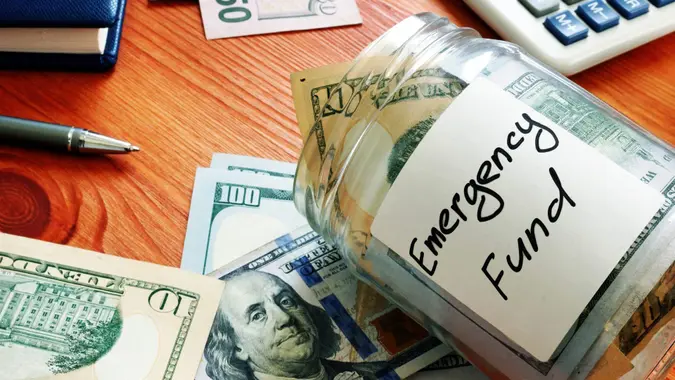5 Common Emergency Expenses — And How Much They Cost on Average

Commitment to Our Readers
GOBankingRates' editorial team is committed to bringing you unbiased reviews and information. We use data-driven methodologies to evaluate financial products and services - our reviews and ratings are not influenced by advertisers. You can read more about our editorial guidelines and our products and services review methodology.

20 Years
Helping You Live Richer

Reviewed
by Experts

Trusted by
Millions of Readers
One thing in life is certain: things are unpredictable unimaginable ways. While you can’t know what the future holds, you can plan for it. Because being unprepared can drain your emergency fund empty and leave you in the poor house.
“If your car breaks down, the cost to fix it can vary greatly,” said Melanie Musson, a finance expert with Clearsurance. “If you have a flat tire, you may need to replace all your tires, which will cost about $600 or more. However, you can expect to pay $2,000 or more for a replacement if your transmission goes. A new radiator will cost around $1,000. If you need a new battery, you have an easy fix for about $100.”
Justin Godur, financial expert and CEO of Capital Max, says understanding these common emergency expenses and their potential impact on your finances is essential for effective financial planning.
“By anticipating these costs and preparing accordingly, you can protect your financial well-being and avoid significant stress during emergencies.”
Below, experts outline exactly how much some of these common emergency expenses will cost you on average.
Car Breakdown
“A car breakdown is one of the most frequent and costly emergency expenses,” Godur said. “The average cost for a major car repair, such as a transmission or engine replacement, can range from $3,000 to $7,000.”
He says even minor repairs, like fixing a brake system or replacing a fuel pump, can cost between $300 to $1,000.
“Regular maintenance and an emergency savings fund can help mitigate these unexpected costs,” Godur said.
Job Loss
According to experts, losing a job is a significant financial shock.
“The average duration of unemployment in the U.S. is about 22 weeks, during which time individuals need to cover living expenses without a steady income,” Godur said.
Musson notes the same.
“If you lose your job and are eligible for unemployment, you can expect to lose half of what you were making,” Musson said. “Unemployment services are a nightmare to work through in many parts of the country, so you can expect to have a lag time of several months, during which time you’ll have no income. So, if you were making $5,000 a month, in a best-case scenario, you’d lose $2,500 a month, and in a worst-case scenario, you’d lose $5,000 a month.”
Godur says that depending on your lifestyle and location, this could mean needing between $10,000 to $20,000 to stay afloat.
“Building an emergency fund with three to six months’ worth of expenses is crucial to weather such storms.”
Hospitalization
“Unexpected medical emergencies can be financially devastating,” Godur highlighted. “The average cost of a three-day hospital stay in the U.S. is around $30,000. Even with insurance, out-of-pocket expenses can be substantial, often ranging from $1,000 to $5,000 for deductibles, co-pays, and non-covered services. Ensuring you have comprehensive health insurance and a health savings account (HSA) can provide a safety net.”
Musson agrees.
“You can count on a hospitalization costing you your maximum out-of-pocket in your insurance plan,” Musson said. “Hospital inpatient stays are costly, and expenses will increase quickly. If your maximum out-of-pocket is $1,500, you can expect to pay that much. If it’s $4,000, your hospital stay will probably end up costing you $4,000.”
“If you don’t have insurance, you can expect that a hospital stay will cost between $2,000 and $4,000 a day,” she added. “If you need surgery or specialized equipment, that cost will be higher.”
Pet Emergencies
“A pet emergency will cost between $500 and $10,000,” said Musson. “If you have pet insurance and your pet’s issue is covered under the plan, you can expect to pay about half of what you’d pay without insurance. If you have a higher level of coverage, you may pay even less.”
Dennis Shirshikov, finance expert and head of growth at GoSummer, similarly agrees.
“Pet emergencies can also incur significant costs,” Shirshikov said. “Emergency vet visits can range from $800 to $1,500 for serious conditions like surgeries or treatments for acute illnesses.”
Home Repairs
“Unexpected home repairs are another common emergency expense,” said Shirshikov. “Issues such as plumbing problems, roof leaks, or HVAC failures can cost anywhere from a few hundred to several thousand dollars.”
He says that on average, homeowners might spend around $2,000 to $4,000 on major repairs.
 Written by
Written by  Edited by
Edited by 

























